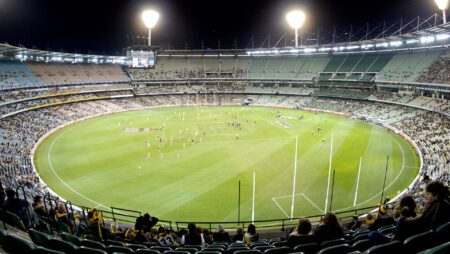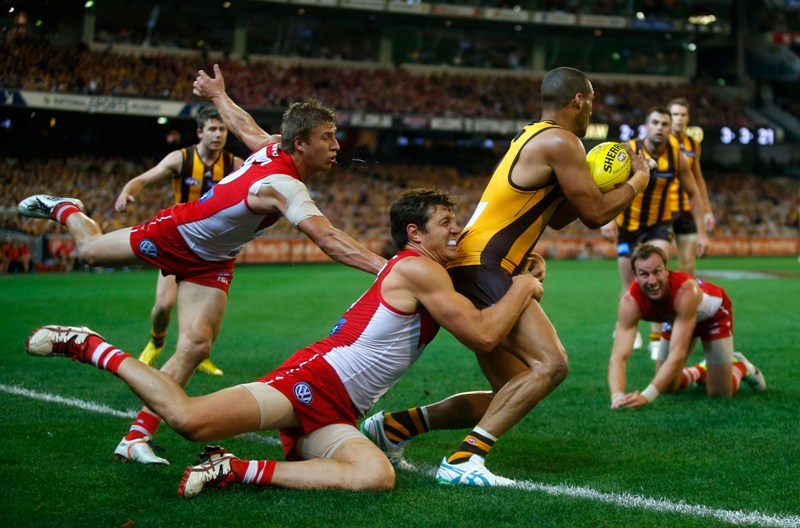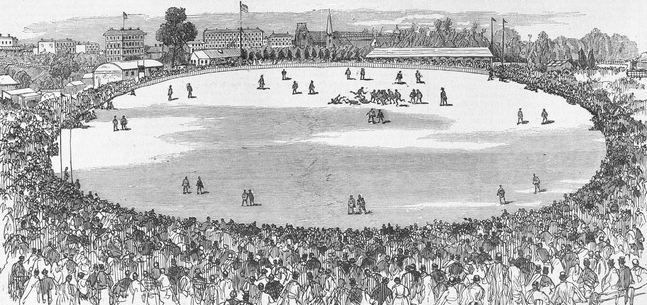
 Introduction to History, Aussie Rules & Facts
Introduction to History, Aussie Rules & Facts Australian soccer is dynamic and has strict rules. There have only been a few known occasions in history when a match was abandoned. It is an extremely rare occurrence. It is not allowed to stop the match, even if a player is injured during the game. The AFL football today is considered the third-largest in terms of spectators. The average number of spectators per match is 33,500.

Origin Story
A detailed historical account of the emergence and formation of Australian rules football was first published in The Yorker magazine in 2009. There are several controversial versions about the exact origins of Australian soccer. At the origin of the game, there were many games played in Great Britain, Ireland, Europe and in Australian cities. All of these games had similar rules.
According to a relatively reliable version, the birthplace of Australian soccer is considered the city of Melbourne. The time of the first match falls around 1858. The captains of the first team were guys named Bryant and Smith. It was conducted by Tom Wills. The primary rules were invented before the first match. It used some elements of the Irish Cade game and Australian rugby.
The first matches between the various British colonies were played in 1879. At first, the game was called the “Melbourne rules game”, then it was called Victorian soccer, only later it was called Australian soccer (Australian rules football). The first years of the game were promoted to the masses due to the positive feedback from spectators, players and clubs of the time.

Dissemination
As soon as Australian footballs became known domestically, there were fans of the game outside the country. The first to play were players from New Zealand, South Africa, later Japan and Scotland. It was especially appreciated in New Zealand. Only a few years after the arrival of the AFL in this country, there were 115 clubs. Later, the geography further expanded and now began to play the AFL in Papua, New Guinea, Malaysia, Singapore, Egypt, Algeria, Indonesia and Vietnam.
In the United States, the first match was played in 1963. It is believed that Australian soccer could have become even more popular if it were not for some factors that hindered the process. For example, one of the problems is the distance between the players. In the classic version, there should be 36 players. However, to assemble such several players for regular play and other serious purposes required expense and effort.
Another factor was that not all countries could find enough space to play. Players in Asia, America and Europe suffered from these problems. Other countries began to play a simplified version of the game, the Nine-a-side.
Between 1980 and 1990, Australian rules football gained new popularity. It began to be played in Canada, Denmark, Sweden, Germany, Samoa, Spain, Argentina, and some Asian countries.
Specification
Australian soccer is characterized by the following features:
- Spectacle. Every sixth inhabitant of this country watches Australian football league games. These games are much more popular here than rugby or European soccer. The game requires players to speed and aggression. In addition, to make the game more exciting, the league regularly introduces new rules. It is true that in cloudy weather the game is much slower. But the number of spectators is not diminished by this.
- Expressiveness. If you’re interested in the embodiment of real sporting brutality, let him watch Australian soccer. It’s got plenty of that. The rules of the game are tough: injured players are not allowed to stop the game. There are only two cases for this: the player is seriously injured, that he can not get up from the ground or the ball returned to the area where it lies. Vivid examples of such episodes can be seen from video clips on YouTube.
- There is no room for simulation. It’s in European soccer simulation brings certain advantages and because of that, it’s hard to resist it. Australian rules football will not tolerate that.
- The AFL is a big-money game. The financial figure of the game speaks volumes. In Australian soccer, there is big, even huge money. The best players are paid 500 million each. In league history, the highest-paid players were Emile Heskey and Alessandro Del Piero. In 2012, the league had a turnover of $425 million. Clubs are paid about $200 million by the league. Television contracts bring in about $1 billion every 5 years.
- The Australian football league is a treasure trove of real soccer stars. The loudest scandals also take place within this league. The favourites of the local newspapers are players Mario Balotelli, Dane Sawan, Gary Ablett and others. Perhaps the reason is the fact that Melbourne is a small city. Every move the residents make is visible to each other. That’s why soccer players are often caught in the eyes of residents, then and immediately on the scoreboards of newspapers and magazines.
- Australian football has a great future. To keep the game entertaining for spectators, the league regularly introduces new rules. And it works. For example, in the 1980s the rules were very different. By now, even the playing fields have changed. Comfortable indoor stadiums make it possible to play as comfortably as possible in any weather. Tougher rules have benefited: previously, due to the slowness of the players, they often collided on the field. With the high speed of the game, this does not happen.
- Gives everyone a chance. AFL holds Combine every year. This is a functional test. It can be taken by anyone who has such a desire and a good level of fitness. This procedure takes place every year in Dublin. There are records in this field. For example, one candidate completed the 20-meter sprint in 2.75 seconds. If someone can do that, they can write a letter to the league and participate in the selection process.
Aussie Rules
The original AFL rules of Australian soccer were enshrined by Tom Wills, J.B. Thompson, Alex Brute, Thomas Smith and Butterworth. These rules consisted of the following points:
- The captains of each team must determine the distance between the goalposts before the game begins;
- The choice of goalposts is determined by drawing lots. Whoever did not draw the lot would take the initial kick from the centre point between the goalposts;
- Tripping and pushing were allowed. Breaking was forbidden;
- The ball could not be picked up from the ground at any time. It could be caught with the hands in a jump or from under the boots;
- If the ball flew out of the area of play, it must return at the same point of the line, etc.
Subsequently, the rules were changed and improved. Each club had the right to introduce its own rules and play by them.
Original Rules
The number of players on the team – 18 people, 4 more spare players. The field should be oval, measuring 185×155. The main goal of each player is to hit the opponent’s goal. With the ball in hand is allowed to make no more than 10 steps. After that, you must either pass or hit the ball on the ground. Set two double goals: a large – for a goal, smaller – also for a goal. A goal to the big goal is awarded 1 point, to the smaller one – 6 points.
Previously, before the early 1990s, the rules of the game were simple. If a player hit another player with his hand, he received a minor penalty. Now a player gets a half-season suspension for such a gesture. Many old fans may not like this rule. But it is these harsh rules that make the game interesting and entertaining.

Field Characteristics
There were strict requirements for the field: the starting points were considered two posts, the distance of which must be 20 yards from the goal in a straight line. The width of the playing area of the field should not exceed 200 yards on each side.
Match Duration
In today’s version of Australian soccer, each player runs between 20 and 22 km during a match. Match duration in the early formative periods was from 60 to 100 minutes in different regions. Currently, the duration of a match is 80 minutes. One match consists of 4 periods of 20 minutes.
In the amateur version, the duration of periods is determined by choice. At professional matches, only timekeepers have access to special game clocks. They are not displayed to players, referees and spectators. The timekeeper informs about the end and the beginning of time by a special signal.
Tournaments
The SAFA or South Australian Football Association was founded in 1877. A few days later the VFA, the Victorian Football Association, appeared. Later SAFA changed its name and became known as AFL.
Australian Football League
The AFL hosts annual matches between 18 teams. The most popular clubs are Essendon and Carleton. Teams from these clubs have each won 16 times. The season begins after the NAB Cup preparations. Games in the season are played in 23 rounds. At the end of the games, 8 teams become playoff participants, and the deciding match determines the ultimate winner, who will carry the title of premiers throughout the next year.
Australian Football League International Cup
This is the largest sporting event on a global scale and in the history of Australian rules football. The first tournament was held in 2002. The last was scheduled for 2020, but the pandemic is postponed. The purpose of the tournament is the development and dissemination of Australian soccer. The rules for selecting teams are very strict. Overseas Australians, Australian football teams and citizens of this country are not allowed to participate in the tournament.
Participants must be citizens of the countries they represent in the tournament. This and other strict requirements allow you to select the best potential players. There is a limit on the number of participants. They are tracked through a list of registered players.
The first competition of this organization Australian rules football college was held in 2002. The second cup was held in 2005, the third – in 2008. The fourth cup was successfully held in 2011. From that year to 2020 Cups were not held. But the next Cup so far has only been rescheduled.
Aussie Rules Football FAQ
Yes, it is different. The AFL ball is similar to a rugby ball, but smaller in size. Its circumference should be between 545 and 555mm. In the early days, when Australian soccer first emerged, the oval ball was played. Nowadays, only branded professional balls are used for it. If the game is to be played during the day, the ball should be orange. If it is to be played at night, a yellow ball is chosen.
Tom Wills. In the 21st century the role played by Tom Wills in the establishment of the game is generally recognised as pivotal. However, in the latter part of the 19th century and much of the 20th, H.C.A. Harrison was accepted as “the father of Australian rules football”.
The field should be oval. There are strict guidelines for the field. They spell out requirements for the area, markings and other parameters.
There are 4 quarters or 4 quarters of 20 minutes in one match. Reporting is done in reverse.
There are currently 13 countries, but the number of players worldwide is growing rapidly.
The match is opened by the referee, who draws lots and decides who starts the match.
A ball up is a ball thrown by the referee on the bounce that the representatives of the playing teams fight over. Whoever catches it, the team starts the game.
Throwing a ball by hand is strictly prohibited in Australian soccer. But it is allowed to run with the ball with a bounce every 15 meters.
The referee changes only at the end of the half.
There are five lines. They are as follows: full-backs, half backs, centerline, full forward and half-forward.
The exchange takes place according to the protocol. According to it, the exchange zone is in front of the exchange gate. The player must go in and out through it. If a player is not exchanged on this zone, he is not allowed to return to the playing area until the end of the match.
If a player is injured and is carried off the field on a stretcher, at least 20 minutes must elapse before returning to the field.
Leave a Reply